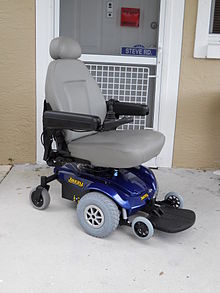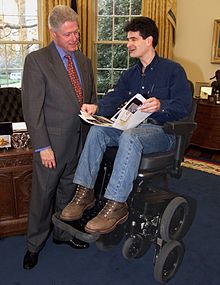From Wikipedia, the free encyclopedia

A front wheel drive chair with a "captain's chair" seat
A
motorized wheelchair,
powerchair,
electric wheelchair or
electric-powered wheelchair (EPW) is a
wheelchair that is propelled by means of an
electric motor rather than manual power. Motorized wheelchairs are useful for those unable to propel a manual wheelchair or who may need to use a wheelchair for distances or over terrain which would be fatiguing in a manual wheelchair. They may also be used not just by people with 'traditional' mobility impairments, but also by people with
cardiovascular and fatigue based conditions.
[edit] History
The electric-powered wheelchair was invented by
George Klein who worked for the
National Research Council of Canada, to assist injured veterans during
World War II.
[1]
[edit] Design
Powerchair design may be categorised by drive system/chassis, battery, controller, seat, and use.
[edit] Drive System/Chassis

Former President Clinton, Dean Kamen and the iBot
Powerchairs are generally four-wheeled and non-folding, however some folding designs exist and other designs may have some ability to partially dismantled for transit.
Four general styles of powerchair drive systems exist: front, centre or rear wheel drive and all-wheel drive. Powered wheels are typically somewhat larger than the trailing/castoring wheels, while castoring wheels are typically larger than the castors on a manual chair. Centre wheel drive powerchairs have castors at both front and rear for a six-wheel layout.
Powerchair chassis may also mount a kerb-climber, a powered device to lift the front wheels over a kerb of 10cm or less.
Some manual wheelchairs may also be fitted with an auxiliary electric power system. This can take one of three forms: integrated with the hub of hand-propelled wheels, so that any force on the pushrims is magnified by the drive system, or mounted under the wheelchair and controlled as for a powerchair, but with the motive force either transmitted to the main wheels via a friction drive system, or delivered directly through an auxiliary drive wheel.
Some experimental all-terrain powerchair designs have been produced with tracks rather than wheels, but these are not in common use.
Other experimental designs have incorporated stair-climbing abilities and
Dean Kamen's
iBOT design featured both stair climbing and the ability to 'stand' on its up-ended chassiss via the use of advanced gyroscopic sensors. The iBOT was at one time a production model, but is no longer marketed.
[edit] Battery
The
electric motors of powerchairs are usually powered by 4 or 5
amp deep-cycle
rechargeable batteries, similar to those used to power
outboard boat engines. These are available in
wet or
dry options. As wet-cell batteries may not legally be carried on an aircraft without removing them from the wheelchair and securing them in a shipping container, dry-cell batteries are preferred for powerchair use. Many powerchairs carry an on-board charger which can be plugged into a standard wall outlet; older or more portable models may have a separate charger unit.
[edit] Controller

A typical joystick controller
Controllers are most commonly an arm-rest mounted joystick which may have additional controls to allow the user to tailor sensitivity or access multiple control modes. The controller may be swing-away to aid in side-transfers. For users who are unable to use a hand controller various alternatives are available such as
sip-and-puff controllers, worked by blowing into a sensor. In some cases the controller may be mounted for use by an aide walking behind the chair rather than by the user.
'Thought-control' of powerchairs, actually working by the detection of brainwaves or nerve signals via sensors on the scalp or elsewhere, has been demonstrated in the laboratory environment.
The seating on a powerchair may be little more than the sling seat found on low-end manual wheelchairs, but is generally more substantial, frequently a 'captain's chair' design. Head rests are a common adaption and specialist seating solutions are available for users who need individually tailored support. Leg rests may be integrated into the seating design and may have powered adjustment for those users who need to vary their leg position. Powerchairs may also have a reclining facility for users who are unable to maintain an upright seating position indefinitely.
Certain high-end powerchairs feature a 'standing' capability in which either the entire seat elevates to bring the user to standing height or the seat-base, seat-back and leg rests move in conjunction to bring the user into an upright position. The powerchair may or may not be able to move while in the elevated position.
[edit] Environment

A large ATV-style outdoor chair
Powerchairs may be designed for indoor, outdoor or indoor/outdoor use. Some indoor chairs may actually resemble a conventional armchair and have neglibible ability to deal with obstacles. Indoor/outdoor chairs generally give more consideration to their size and the need to navigate within a home environment than do outdoor chairs.
Some very large outdoor powerchairs have been designed with cross-country mobility in mind and show design convergence with other types of cross-country vehicle.
Powerchairs are generally prescribed for use by users who are unable to use a manual wheelchair. However in both the US (
Medicare and some private insurers) and the UK (
NHS) powerchairs are generally not prescribed to users who have any ability to walk within the home, even if that ability is so functionally constrained as to be practically useless and where the user is unable to use a manual wheelchair independently. Disability rights activists are campaigning for prescription procedures to focus on an individual needs based assessment rather than on inflexible application of prescription rules. The restricted prescribing leads to many users being forced to procure a solution privately, in some cases settling for a powerchair or a
mobility scooter that is less than ideal to their needs but which falls within their budget.
The use of powerchairs is not restricted solely to users unable to use manual chairs. Any disabled person with a mobility, fatigue or pain-based impairment or cardio-vascular issues may find a powerchair advantageous in some circumstances, however existing prescription practises generally means that powerchairs for such use must be privately procured or hired for the occasion.
[edit] Limitations
Access adaptions such as wheelchair spaces on public transport and wheelchair lifts are frequently designed around a typical manual wheelchair (in the UK referred to as a 'reference wheelchair'). Unfortunately powerchairs frequently exceed the size and weight limits of manual wheelchairs as they are not constrained by the ability of the user to self-propel. This may mean that certain powerchair designs are unable to use some wheelchair spaces and may be too heavy to use some wheelchair lifts.
[edit] See also
[edit] References







